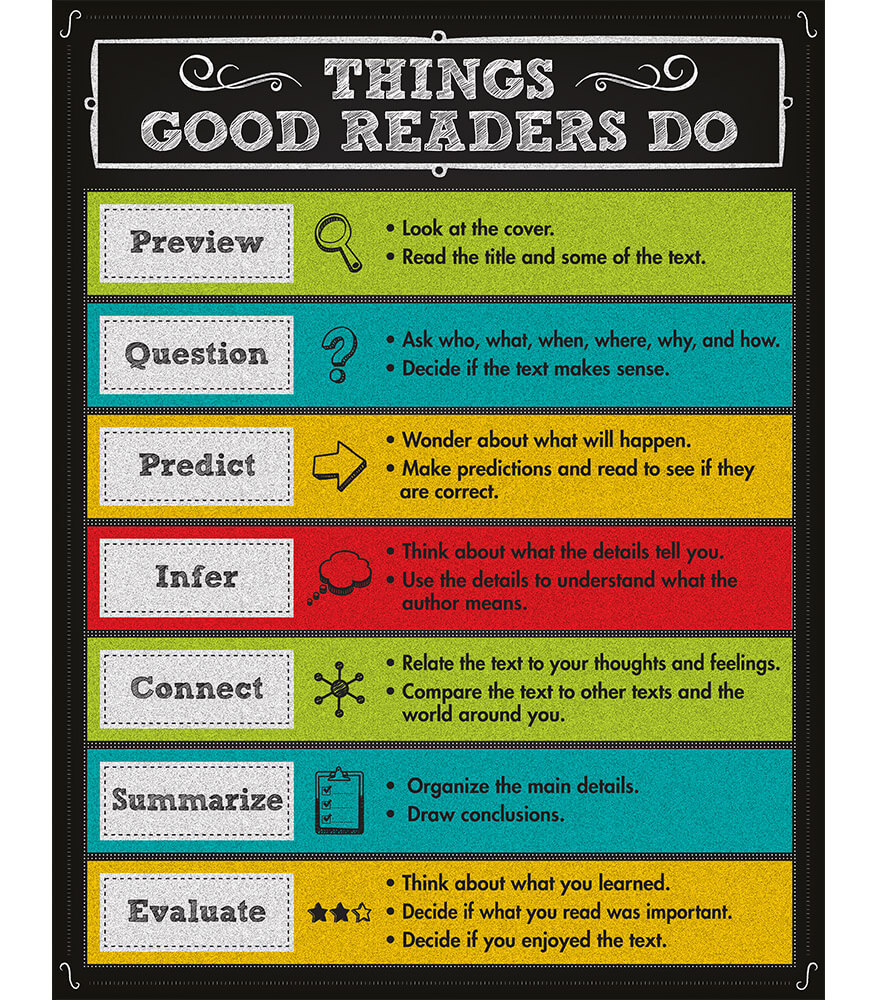What Good Readers Do Anchor Chart

In classrooms across the nation, a deceptively simple tool is quietly revolutionizing reading comprehension: the "What Good Readers Do" anchor chart. This visual aid, packed with actionable strategies, isn't just a decoration; it's a dynamic guide empowering students to become active, engaged, and ultimately, more successful readers. But how effective are these charts, and what impact do they truly have on a student's literacy journey?
The "What Good Readers Do" anchor chart is a collaboratively created visual representation of the strategies proficient readers employ. These charts typically outline key skills such as making predictions, asking questions, connecting to prior knowledge, visualizing, inferring, summarizing, and monitoring comprehension. While seemingly straightforward, the implementation and efficacy of these charts are subjects of ongoing discussion among educators and literacy experts.
The Anatomy of a "What Good Readers Do" Anchor Chart
A typical anchor chart is usually created in partnership with students, making it a shared learning experience. This co-creation process fosters ownership and understanding. Common elements include a clear title, concise explanations of each reading strategy, and often, visual cues like drawings or symbols.
Making Predictions: Encouraging students to anticipate what might happen next based on textual clues. This activates prior knowledge and promotes engagement. Asking Questions: Teaching students to formulate questions before, during, and after reading to clarify understanding. Questioning cultivates a critical and inquisitive approach to reading. Connecting to Prior Knowledge: Helping students relate the text to their own experiences and existing knowledge. Connections build deeper meaning and improve retention. Visualizing: Promoting the creation of mental images based on the text to enhance comprehension. Visualization makes the text more concrete and memorable. Inferring: Guiding students to draw conclusions based on textual evidence and background knowledge. Inference skills are crucial for understanding implied meanings. Summarizing: Teaching students to condense the main ideas of the text into a concise summary. Summarizing reinforces comprehension and helps identify key information. Monitoring Comprehension: Equipping students with strategies to identify when their understanding breaks down and how to fix it. This promotes self-regulation and independence.
Expert Opinions and Research Findings
Dr. Emily Hanford, a senior education correspondent whose reporting focuses on literacy, has highlighted the importance of explicit instruction in reading strategies. While she hasn't specifically addressed anchor charts, her work emphasizes the need for systematic teaching of skills often represented on these charts.
Research from organizations like the International Literacy Association (ILA) supports the use of visual aids and strategy instruction to improve reading comprehension. Their publications often advocate for creating classroom environments that support active reading and metacognitive awareness.
However, some educators caution against relying solely on anchor charts without explicit instruction and modeling. They emphasize that students need to be taught *how* to use these strategies effectively, not just be presented with a list of them.
The Implementation Challenge
The effectiveness of a "What Good Readers Do" anchor chart hinges on how it's implemented in the classroom. It's not enough to simply display the chart; teachers need to actively model and teach each strategy.
Modeling: Teachers should demonstrate how they personally use these strategies when reading aloud or thinking aloud. This provides a clear example for students to follow. Guided Practice: Students need opportunities to practice using these strategies under the guidance of the teacher. This allows for immediate feedback and support. Independent Application: Students should be encouraged to apply these strategies independently when reading on their own. This fosters self-reliance and ownership of learning.
Furthermore, the anchor chart should be a living document, constantly evolving as students learn and refine their reading skills. This involves revisiting the chart, adding new strategies, and revising existing ones based on student needs.
One potential drawback is the temptation to treat the chart as a static checklist.
"The danger is that it becomes just another poster on the wall that students ignore,"warns veteran teacher Sarah Miller. She emphasizes the need for constant engagement and purposeful integration into daily reading activities.
Beyond the Classroom Walls
The benefits of a well-implemented "What Good Readers Do" approach extend beyond the classroom. Students equipped with these strategies become more confident and independent readers in all aspects of their lives.
Improved reading comprehension translates to greater success in other academic subjects. It also fosters a lifelong love of reading and learning.
By empowering students with the tools to become active and engaged readers, educators are laying the foundation for a future of critical thinking and informed citizenship. Active readers are active learners, capable of navigating a complex world with confidence and understanding.
Looking Ahead
The "What Good Readers Do" anchor chart is a valuable tool, but it's just one piece of the puzzle. Ongoing research and professional development are essential to ensure that educators are equipped with the knowledge and skills to effectively teach reading comprehension.
Moving forward, it's crucial to focus on: Explicit instruction in reading strategies, ongoing assessment of student understanding, and adaptation of the anchor chart to meet the specific needs of diverse learners.
Ultimately, the goal is to cultivate a classroom culture that values reading and empowers all students to become proficient, engaged, and lifelong readers. The humble anchor chart, when used thoughtfully and intentionally, can be a powerful catalyst in achieving that goal.

















